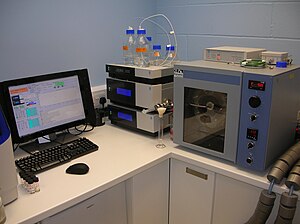
Countercurrent chromatography (CCC, also counter-current chromatography) is a form of liquid–liquid chromatography that uses a liquid stationary phase that is held in place by inertia of the molecules composing the stationary phase accelerating toward the center of a centrifuge due to centripetal force[1] and is used to separate, identify, and quantify the chemical components of a mixture. In its broadest sense, countercurrent chromatography encompasses a collection of related liquid chromatography techniques that employ two immiscible liquid phases without a solid support.[1][2] The two liquid phases come in contact with each other as at least one phase is pumped through a column, a hollow tube or a series of chambers connected with channels, which contains both phases. The resulting dynamic mixing and settling action allows the components to be separated by their respective solubilities in the two phases. A wide variety of two-phase solvent systems consisting of at least two immiscible liquids may be employed to provide the proper selectivity for the desired separation.[3][4]
Some types of countercurrent chromatography, such as dual flow CCC, feature a true countercurrent process where the two immiscible phases flow past each other and exit at opposite ends of the column.[5] More often, however, one liquid acts as the stationary phase and is retained in the column while the mobile phase is pumped through it. The liquid stationary phase is held in place by gravity or inertia of the molecules composing the stationary phase accelerating toward the center of a centrifuge due to centripetal force. An example of a gravity method is called droplet counter current chromatography (DCCC).[6] There are two modes by which the stationary phase is retained by centripetal force: hydrostatic and hydrodynamic. In the hydrostatic method, the column is rotated about a central axis.[7] Hydrostatic instruments are marketed under the name centrifugal partition chromatography (CPC).[8] Hydrodynamic instruments are often marketed as high-speed or high-performance countercurrent chromatography (HSCCC and HPCCC respectively) instruments which rely on the Archimedes' screw force in a helical coil to retain the stationary phase in the column.[9]
The components of a CCC system are similar to most liquid chromatography configurations, such as high-performance liquid chromatography (HPLC). One or more pumps deliver the phases to the column which is the CCC instrument itself. Samples are introduced into the column through a sample loop filled with an automated or manual syringe. The outflow is monitored with various detectors such as ultraviolet–visible spectroscopy or mass spectrometry. The operation of the pumps, CCC instrument, sample injection, and detection may be controlled manually or with a microprocessor.
- ^ a b Berthod, Alain; Maryutina, Tatyana; Spivakov, Boris; Shpigun, Oleg; Sutherland, Ian A. (2009). "Countercurrent chromatography in analytical chemistry (IUPAC Technical Report)" (PDF). Pure and Applied Chemistry. 81 (2): 355–387. doi:10.1351/PAC-REP-08-06-05. ISSN 1365-3075. S2CID 28365063.
- ^ Ito, Y.; Bowman, RL (1970). "Countercurrent Chromatography: Liquid-Liquid Partition Chromatography without Solid Support". Science. 167 (3916): 281–283. Bibcode:1970Sci...167..281I. doi:10.1126/science.167.3916.281. PMID 5409709. S2CID 21803257.
- ^ Yoichiro Ito; Walter D. Conway, eds. (1996). High-speed countercurrent chromatography. Chemical analysis. New York: J. Wiley. ISBN 978-0-471-63749-3.
- ^ Liu, Yang; Friesen, J. Brent; McApline, James B.; Pauli, Guido F. (2015). "Solvent System Selection Strategies in Countercurrent Separation". Planta Medica. 81 (17): 1582–1591. doi:10.1055/s-0035-1546246. PMC 4679665. PMID 26393937.
- ^ Ito, Yuko; Goto, Tomomi; Yamada, Sadaji; Matsumoto, Hiroshi; Oka, Hisao; Takahashi, Nobuyuki; Nakazawa, Hiroyuki; Nagase, Hisamitsu; Ito, Yoichiro (2006). "Application of dual counter-current chromatography for rapid sample preparation of N-methylcarbamate pesticides in vegetable oil and citrus fruit". Journal of Chromatography A. 1108 (1): 20–25. doi:10.1016/j.chroma.2005.12.070. PMID 16445929.
- ^ Tanimura, Takenori; Pisano, John J.; Ito, Yoichiro; Bowman, Robert L. (1970). "Droplet Countercurrent Chromatography". Science. 169 (3940): 54–56. Bibcode:1970Sci...169...54T. doi:10.1126/science.169.3940.54. PMID 5447530. S2CID 32380725.
- ^ Foucault, Alain P. (1994). Centrifugal Partition Chromatography. Chromatographic Science Series, Vol. 68. CRC Press. ISBN 978-0-8247-9257-2.
- ^ Marchal, Luc; Legrand, Jack; Foucault, Alain (2003). "Centrifugal partition chromatography: A survey of its history, and our recent advances in the field". The Chemical Record. 3 (3): 133–143. doi:10.1002/tcr.10057. PMID 12900934.
- ^ Ito, Yoichiro (2005). "Golden rules and pitfalls in selecting optimum conditions for high-speed counter-current chromatography". Journal of Chromatography A. 1065 (2): 145–168. doi:10.1016/j.chroma.2004.12.044. PMID 15782961.